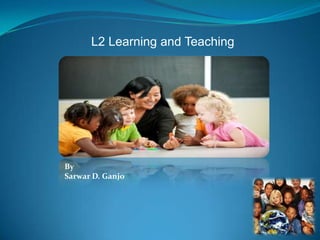
L2 learning and teaching
- 1. L2 Learning and Teaching By Sarwar D. Ganjo
- 2. Topics: 1- Definition 2- What exactly does the L2 Learning come from? 3- A basic disagreement among different linguistic perspectives. 4- How does the learner acquire L2 knowledge. 5- Approaching Near- Native competence 6- Implications for L2 Learning and Teaching
- 3. Definition: A second language (L2) is any language learned after the first language or mother tongue (L1).
- 4. What exactly does the L2 Learning come from? 1- A system of knowledge about a second language which goes will beyond what could possibly have been taught . 2- Patterns of recurrent elements that comprise components of L2 specific knowledge: Vocabulary lexicon, morphology word structure, phonology sound System, syntax grammar, and discourse (ways to connect sentences and organize information. 3- How to encode particular concepts in the L2 including grammatical notions of time, number of referents, and the semantic role of elements.
- 5. 4- Pragmatic competence, or knowledge of how to interpret and convey meaning in contexts of social interaction. 5- Means for using the L2 in communicative activities: Listening Speaking, Reading, Writing. 6- How to select among multiple language systems, and how to switch between languages in particular social contexts and for Particular purposes. 7- Communicative competence: all of the above plus social and cultural knowledge required for appropriate use and interpretation of L2 forms.
- 6. A basic disagreement among different linguistic perspectives : 1- an abstract system of underlying rules or principle. 2- a system of linguistic patterns and structures. Or 3- a mean of structuring information and a system of communication.
- 7. How does the learner acquire L2 knowledge: 1- Innate capacity: The natural ability of people to acquire language. 2- Application of prior knowledge, the initial state of L2 includes knowledge of L1 ( and language in general) and the processes of SLA includes interpretation of the new language in terms of that knowledge. 3- Processing of language input: Input is one of the most important elements in the process of second language acquisition (SLA). As Gass (1997) points out, second language (L2) learning simply cannot take place without input of some sort.
- 8. 4- Interaction: Social perspectives generally hold that SLA Benefits from the active engagement of learners in interaction, Or participation in communicative events. 5- Restructuring of the L2 knowledge system 6- Mapping of relationships or associations between linguistic function and forms. 7- Automatization: Mean standard deviation decreases more than mean RT.
- 9. Why are some learners more successful than others: 1- Social context : Social context is the indirect and direct influence individuals are in constant communication and within Involvement of by means as role player or participants 2- Social experience: quantity and quality of L2 input and interaction are determined by social experience, and both have significant influence on ultimate success in L2 Learning. 3- Relationship of L1 and L2: We can say all languages are learnable, but not all L2s are equally easy for speakers of particular L1s to acquire.
- 10. 4- Age: commonly believed that children are more successful L2 learners than adults. 5- Aptitude: Learners differ in capacity to discriminate and process auditory input, to identify patterns and make generalizations, and to store linguistic elements in memory. 6- Motivation: Motivation largely determines the level of effort which learners expend at various stage in their L2 development and it is often a key to ultimate level of proficiency. 7- Instruction: Quality of instruction clearly makes A difference in formal context of L2 learning.
- 11. Approaching Near- Native competence -The most likely level of linguistic production to retain some identifiably "foreign" feature is pronunciation, especially if L2 learning began after the age of twelve or so. - learners will have to select ,from a more limited lexical repertoire than do native speakers of the same educational level, will not use words with the same probability of occurrence in the same phrasal units (e.g. collocations), and will not recognize connotations and allusions which require cultural information and experience.
- 12. - older L2 students who do approach "near-native" competence almost surely have benefitted from extensive and varied input, feedback which includes some correction and focus on grammatical form, and very high levels of motivation.
- 13. - At the same time, we must recognize that many intelligent' hard-working, highly-motivated students will not approach this level of competence. - It is important for language teachers, in particular, to accept the fact that "native-1ike" production is neither intended nor desired by many learners whose goals for L2 use do not include identification with native speakers of the language nor membership in its native speech communities.
- 14. Implications for L2 Learning and Teaching: - Consider the goals that individuals and groups have for learning an additional language. -Set priorities for learning/teaching that are compatible with those goals. -Approach learning/teaching tasks with an appreciation of the multiple dimensions that are involved: linguistic, psychological, and social. - Understand the potential strengths and limitations of particular learners and contexts for learning, and make use of them in adapting learning/teaching procedures. - Be cautious in subscribing to any instructional approach which is narrowly focused or dogmatic. There is no one "best" way to learn or teach a second language. -Recognize achievement in incremental progress.
- 15. Thank you And be patient, Learning a language takes time.
